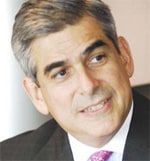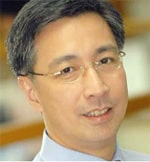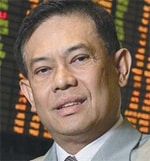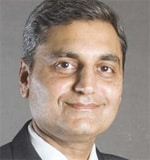 |
|
Schleimer: The Clean Air Act could be used to regulate greenhouse gases |
With the May general election safely behind it, the Philippine government hopes to use the next three years of relative political quietude to move ahead with its reform program and to boost spending to keep the economy in its newly attained higher orbit. Invigorated by rising cash inflows from its 10 million overseas workers and supported by increased government spending on infrastructure, the Philippine economy is enjoying its fastest growth in 20 years. New industries such as tourism, mining and business process outsourcing (BPO) offer more promise for the future.
The changing face of this vibrant Southeast Asian economy reflects a shift from agriculture to services, including software development, architectural design and call centers. The rapidly expanding services sector now accounts for half of economic output. The increasingly sophisticated BPO industry, which employed 244,675 people in 2006, is projected to provide about 1 million jobs in 2010. With its white-sand beaches, this 7,100-island archipelago expects to attract a record 3 million tourists this year. Its rich mineral resources are also drawing such major foreign investors as Sumitomo Metal Mining and BHP Billiton.
The next three years will be crucial, as the government of president Gloria Macapagal Arroyo seeks to maintain the economic momentum in the remainder of its term by using every means at its disposal to increase spending on roads, ports, airports and schools to smooth the way for future growth. “We are the only administration that has not experienced negative growth in any quarter,” Arroyo said in a televised address last month to announce that gross domestic product expanded at a surprisingly fast 7.5% annual rate in the second quarter of 2007, following an upwardly revised 7.1% growth rate in the first quarter. “The regular boom-and-bust cycle is three years, but it has not happened to us,” she said.
 |
|
Zobel: we are seeing increased occupancy rates, as well as higher rental rates at our malls. |
The government hopes to realize between $5 billion and $7 billion from the privatization of energy assets this year, including the generation facilities of National Power Corporation, the National Transmission Corporation’s 25-year concession, and the remaining 40% stake in PNOC Energy Development Corporation (PNOC-EDC). Arroyo has ordered an acceleration of the sales to finance the government’s spending program and reduce the budget deficit to a maximum of $1.3 billion.
Finance secretary Margarito “Gary” B. Teves says the sale of the PNOC-EDC stake alone could generate about $750 million. “The policy preference of the government is to move out of industries that could be better handled by the private sector,” he says. “We want to encourage private investment in the power industry.”
The government wants to hold the line on the budget deficit and yet increase spending on social services and infrastructure to sustain economic growth, according to Teves. He says a priority will be to crack down on big-ticket tax evaders. Government infrastructure spending and other capital outlays rose 56% in the first seven months of this year compared with the same period last year.
Strong Economy, Strong Currency
The strong economy and rising foreign inflows have pushed up the value of the peso. While the strong peso could be a potential threat to future growth if it hurts exporters, it is helping to keep inflation under control and to reduce payments on the country’s large foreign debt. “The peso appreciation will adversely affect some exporters less than others, depending on their input of materials from abroad, such as the electronics industry, which has high foreign inputs,” Teves says. Garment exporters are flexible and have the ability to switch to other lines or to new markets, he adds. “We will do what we can to help exporters by providing hedging facilities,” he says.
 |
|
Tan: banks are going to need scale. we saw an opportunity to strengthen our franchise. |
Remittances from overseas Filipino workers for the first seven months of 2007 totaled $7 billion, an increase of 18% from the same period a year earlier. These inflows help to boost household consumption, which accounts for 70% of GDP, and to support a booming real estate market.
“A large part of the continued surge in overseas foreign worker remittances is finding its way into the organized real estate sector in terms of additional demand for residential products,” says Jaime Augusto Zobel de Ayala, chairman and CEO of Ayala, the holding company of one of the largest business groups in the Philippines. “With the heightened activity in the domestic BPO sector, there is huge unmet demand for office space, both in and out of the central business districts, as well as growing purchasing power among the 20-to-30-year-olds employed in the BPO sector,” he adds.
Residential unit bookings at Ayala Land increased by 69% in the first half of 2007 compared to the same period a year earlier. “On the retail front, we are seeing increased occupancy rates, as well as higher rental rates at our malls, even as we continue to expand our shopping center gross leasable area,” Zobel says.
Ayala Land has big-acreage holdings south of Manila, which Zobel describes as an emerging economic growth corridor. In Laguna, the company is building an integrated, large-scale community called Nuvali, incorporating environmentally friendly features in a lakeside setting. It will include a congestion-free road network connecting the community’s many neighborhoods to each other and to mega-Manila, whose 14 million people struggle with traffic jams rivaling those of Bangkok.
The Philippines’ GDP growth rate of 7.3% in the first half of 2007 was up from 5.5% for all of last year. The advance was broad based, with particular strength in electronics exports, construction, transportation, communications and manufacturing, as well as an increase in agriculture, despite a persistent drought.
Foreign Investors Flood In
The attractiveness of the country to foreign investors was highlighted in May, when the Philippines beat out China and Thailand for the site of Texas Instruments’ new $1 billion semiconductor test and assembly plant. The work ethic of the English-speaking workers at the company’s existing microchip plant in the Philippines, as well as a package of incentives from the government, convinced the US company that this was the best place in the region for it to expand.
 |
|
Lim: a big deterrent to foreign investors is that the philippines does not have specialized bankruptcy courts. |
Computer maker Dell opened its second call center in the Philippines in March. Ford Philippines recently launched production at its Flexible Fuel Vehicle engine plant. SunPower is expanding its solar-cell manufacturing plant to serve growing export markets. South Korean shipbuilder Hanjin Heavy Industries will spend $1.7 billion on its Philippines shipyard. China Overseas Shipping is considering a multi-billion-dollar trans-shipment hub. For the first half of 2007, approved foreign investments increased 48% from the same period a year earlier.
The United States is the Philippines’ number-one trading partner. Prodded by the garments sector, the Philippines is pursuing a trade enhancement agreement (TEA) with the US that would practically translate to a phased negotiation of a free trade agreement (FTA), says Peter B. Favila, secretary of trade and industry. “The rationale for this approach is to manifest the tangible gains of an FTA under the initial phase as a way of bringing in the more sensitive sectors at a later phase,” he says. The US, however, is continuing to seek a comprehensive FTA with the Philippines.
While slower growth in the US economy could hurt Philippine exports in the months ahead, growing local demand is the main driver of the Philippine economy. “The Philippines continues to be a preferred global destination for BPO providers because of the country’s ability to deliver better-quality service at a significantly reduced cost,” Favila says. Outsourcing is expanding beyond call centers and information technology to accounting, human resources, financial analysis, design engineering, animation, medical services, legal services, insurance and banking processes, map-making, research and content creation for publishing, he says.
“Revenue from BPO companies is exceeding that of electronic manufacturers in the current quarter,” says Gregory L. Domingo, executive director of SM Investments, a major retail, real estate development and financial services group, which operates the Mall of Asia on Manila’s harborfront and will open a new convention center by the end of the year. SM’s property group is building office facilities for BPO and call centers in various locations around the country.
“The other bright spot that could be a big savior for the Philippines is tourism,” Domingo says. Cebu, the so-called “Queen City of the South,” will lead the charge in tourism, he says. SM has refurbished a 400-room hotel in Cebu, next to the company’s mall. The country’s second-largest city, Cebu is the main hub outside of the capital for international flights into the Philippines and is an important center of commerce, trade and industry. Tourist arrivals by country of origin are led by South Korea, followed by Japan, the US and China.
Good economic management has also played a major role in the Philippines’ improved performance. President Arroyo, a former economist, has forced the government to get its fiscal house in order. Meanwhile, central bank governor Amando M. Tetangco Jr. has kept a close watch on inflation. The latest estimate, he says, is that inflation will be between 2.6% and 3.1% this year, well below the 4%-5% target range. “The stronger peso is helping to moderate inflation,” he explains. “The appreciation of the currency has also reduced the peso equivalent of our foreign-debt-service requirements.”
Meanwhile, the country’s financial system is the strongest it has been in many years as a result of better asset quality and higher capitalizations, Tetangco says. The non-performing loan (NPL) ratio of commercial and universal banks is 5.3%, down from a peak of 18% in 2001. “We hope to see an NPL ratio of less than 5% by the end of 2007,” he says.
Banks Join Forces
The Philippine banking industry continues to consolidate, and another three to five bank mergers are likely before 2010, Tetangco says. “Merger talks are going on right now,” the central bank governor notes. “This process is being pushed further by increased competition in the financial system, more stringent capital adequacy requirements, and the desire of banks to stay near the top,” he explains. The banks need to be big enough to be able to afford the investments in new technology that are required to stay competitive, he adds.
 |
|
Schleimer: The Clean Air Act could be used to regulate greenhouse gases |
After acquiring the larger Equitable PCI Bank last year to become the country’s second-largest lender, Banco de Oro agreed in August to purchase the Philippine consumer-banking operations of US-based American Express Bank, which it plans to consolidate with its private banking subsidiary. “Going forward, banks are going to need scale,” says Nestor Tan, president of Banco de Oro. Discussing the acquisition of Equitable PCI, he says, “We saw an opportunity to strengthen our franchise, and Equitable complemented the business we have. There is very little overlap between us.”
Aurelio R. Montinola, president and CEO of Bank of the Philippine Islands (BPI), says there is room for a handful of large banks, and after that, the rest will remain niche banks. “Banks have a choice of growing organically or making acquisitions,” he says. “We are doing a little of both.” Many of the banks that remain as takeover targets are relatively small, he notes.
BPI is the oldest bank in the Philippines but also one of the most innovative. “Some of our ideas are not new to banking, but we are bringing them to an emerging market country,” Montinola says. The bank recently introduced a loyalty program using a microchip on a credit card and is also a leader in mobile phone banking using short message system (SMS) capabilities. “If you focus on your customers and your people, the business results will follow,” Montinola says. “Managing a company in an emerging market requires flexibility,” he adds. “At the same time, you have to be aware of what is happening globally because it affects us a lot more and quicker than you may realize.”
Sanjiv Vohra, country officer for Citi, which has had a presence in the Philippines for 105 years, says the bank is among the top six or seven in the country in terms of assets, loans and deposits. “We are among the top three banks in the Philippines in terms of revenue, with a dominance in products such as credit cards, personal loans and private banking,” he says. Citi also is the number-one custodian bank and lead arranger of most government bond issues.
Citi maintains its regional operating headquarters in the Philippines, where the supply of skilled English-speaking workers at a competitive cost makes it an ideal location for business processing and call centers, according to Vohra. “Filipinos have a high emotional quotient and an ability to relate to people that is ideal for customer contact and service,” he says. The Philippines has a much more Westernized culture than India, with which it competes for BPO and call-center business, he adds.
Citi has 3,200 employees in the Philippines and more than 99% of them are local Filipinos, according to Vohra. The bank is very active in community-support programs, including Gawad Kalinga, which is building homes for the poor and creating sustainable communities with health, education and job programs provided by volunteer workers. Through Project BLUE, or Buildings for Literacy, Understanding and Education, Citi Philippines has donated 15 school buildings and a dozen computer labs. It also offers a junior bankers conference and a finance educator’s award, as well as advice on how to use credit wisely.
Less than 1% of Filipinos are investors in the stock market, says Francisco Lim, president and CEO of the Philippine Stock Exchange. “They don’t know the market, and they think that it is only for people from Metro Manila,” he says. “There is a basic lack of education about investing.” Institutional investors in the stock market are evenly divided between foreign and domestic participants.
“One big deterrent to foreign investors is that the Philippines does not have specialized bankruptcy courts,” Lim says. The exchange is advocating a change in the bankruptcy laws to enable out-of-court rehabilitation of a company if 90% of the creditors approve. It is also backing a proposed law designed to lessen credit risks and loan defaults. Lim says enactment of the Credit Information System Act would lessen the likelihood of defaults by making the credit-investigation process less tedious and less costly, while increasing the accuracy of credit information.
Finally, the exchange is advocating the passage of the PERA Act to create personal equity retirement accounts, similar to 401(k) plans in the US, with contributions that are 100% deductible from taxable income.
Foreign investor demand has played a key role in lifting the market this year. Overseas investors have realized additional gains from the strength of the peso, Lim says. “Meanwhile, the good performance of the stock market also has contributed to the strength of the peso,” he says.
Gordon Platt



